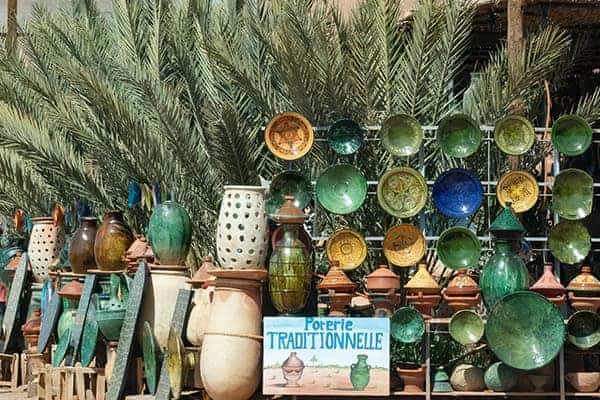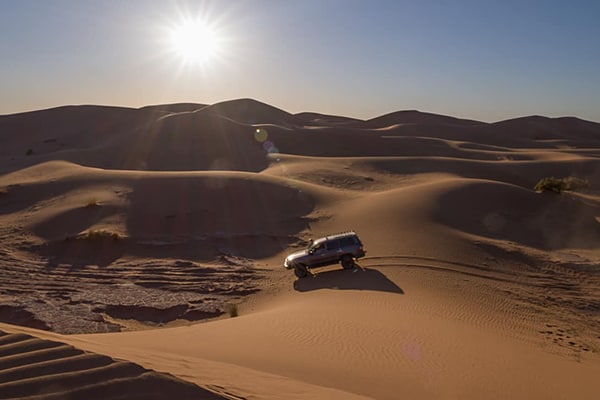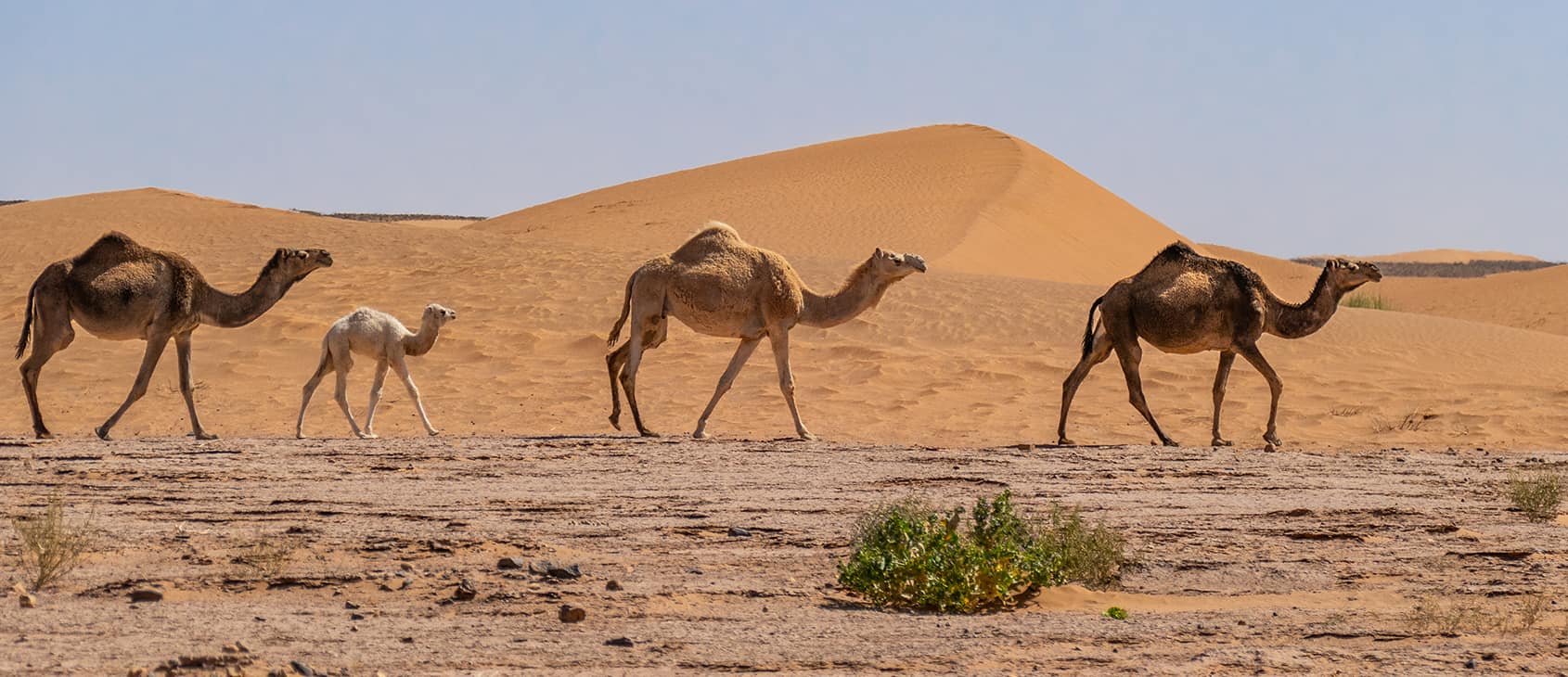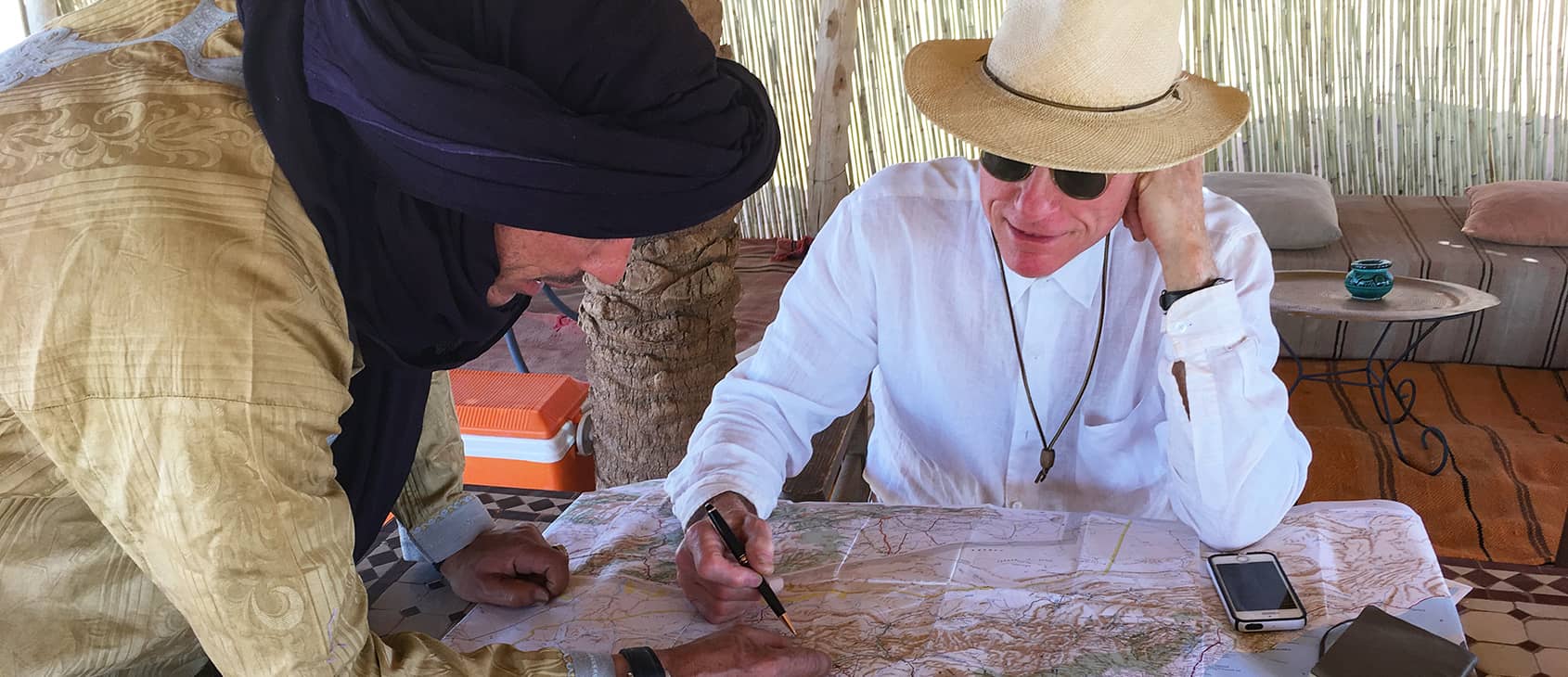Transport options to the camp
Half the fun is getting there!
There are basically 5 options, of which Option 1 is by far the most popular.
- In a 4WD with one of our drivers. This is the most popular option. Our drivers are not just experts in driving in challenging desert terrain, but are also highly knowledgeable, and fun to be with. Not only do they take all the stress out of the journey, they also provide a revealing insight into the Moroccan way of life and its culture.
- Self drive to M'Hamid. We then collect you in a 4WD for the desert portion of the trip to the camp. You can park your rental vehicle securely in M'Hamid (not that there is anything to worry about because it's very safe).
- Self drive to the camp in a 4WD. There are a limited number of 4WD for rent in Marrakech. This is a good option for those seeking adventure. Driving in the desert requires some skill and is a little technical in places. A guide is required. GPSs might just about suffice in good weather, but in poor visibility a guide is essential for your safety!
- Commercial flight. There are flights twice per week from Casablanca to Zagora (3 hours from the camp), on Friday, Saturday and Sunday., Whilst there are only a limited number of flights, this is sometimes a potential option for guests arriving and departing from Casablanca.
- Helicopter. For those on a tight deadline, although it's not cheap! A return flight from Marrakech within a 24-hour period costs about 11,000 USD.
Getting to the camp by 4WD
It's a spectacular trip — the drive is a reason in itself for visiting the desert. It's an eclectic mix of mountain passes, lush valleys, Berber villages clinging to the mountain side, dilapidated kasbahs, palm groves and awe inspiring rock formations. The sense of expectation rises as one travels through a myriad of landscapes from the frenetic activity of Marrakech to the calm and open vistas of the desert.
The trip to the desert is quite long, about 9 hours, but it should not be rushed. There's a timelessness about the desert, and the trip should not be governed by the need to arrive anywhere at a specific time. For sure, one wants to arrive at the camp near sunset, but you don't want to hurry either.
The preferred itinerary is to spend one night at a maison d'hôtes en route to the desert, two or three nights in the desert and then return to Marrakech in one day via Foum Zguid (this being a circular route). The 3 guest houses we partner with at either Ait Benhaddou or the Draa Valley are superb, and greatly enhance your desert experience.
If going from Marrakech to Fez (or vice versa) we recommend the 5-day trip with one night at Ait Benhaddou and one night in Todra Gorge en route to Fez.
If you only have limited time and are going directly to the camp from Marrakech we suggest you depart as early as possible, about 07:00. If staying en route a departure sometime after breakfast is fine.
Please note that there are no specific itineraries, because everyone has different interests and wants to do things at a different pace. Your driver will advise you of the best places to stop, according to your interests. He will also suggest places to stop for lunch in accordance with your dietary wishes! Please see for more information please see the getting there section.
Read about the trip to the desert
Commercial flights within Morocco
There are only a limited number of internal flights within Morocco. The nearest airport to the camp is Zagora, a trip of 3 hours. The only flight to Zagora is from Casablanca on Friday, Saturday and Sunday. There are therefore no direct flights from Marrakech. This flight can be useful if you are entering or departing from Casablanca, or going to Fez, where you could take a transfer on the highway, which takes 4 hours.
Lots to see
The most noteworthy are …
- Ait Benhaddou

- Ait Benhaddou (30 min north of Ouarzazate) is located in the foothills of the High Atlas and is a UNESCO World Heritage Site. The ksar (being a group of dwellings) is a striking example of southern Moroccan architecture, the earthen construction techniques dating back over 1,000 years. Setting for Lawrence of Arabia, Game of Thrones and other epics, it is the most visited kasbah in the region.
- Telouet

- Telouet (30 minutes south of Tizi n'Tichka pass) is a rambling and decaying Kasbah built in the 1800s by the Glaoui family who ruled the Draa Valley until Morocco's independence in 1953. Never inhabited, the interior reveals mosaics and intricate woodwork that could compete with the Bahia Palace. Very few tourists visit it, and well worth the trip.
- The Draa Valley

- Tthe Draa Valley from Agdz to Zagora is home to 3 million date palms; over 9 million kilos of dates are harvested each year. Also known as 'Valley of the Kasbahs', it's full of crumbling kasbahs. The Draa River rises in the High Atlas and used to run through the desert to Tan-Tan on the Atlantic coast. However, with the creation of the dam in Ouarzazate and encroachment of dunes in the desert, it now only flows until Zagora, and in freak weather conditions to M'Hamid and the desert.
- Tamnougalt

- Tamnougalt, just 10 minutes south of Agdz, was built in the 16th century and is one of the oldest mud brick ksars and is well preserved. It's a seamless blend of Arab, Andalucian and Berber Jewish architecture.
- Tamegroute

- Tamegroute, 15 minutes south of Zagora, has been a religious centre since the 11th century. It houses 4,200 original manuscripts in the library of the zaouia (Islamic religious school). Tamegroute also produces a distinctive green pottery, introduced by the founders of the religious brotherhood Naciria, and which you can see being made in its toasty kilns.

Are we there yet?

Expert driving skills are essential

Off-road in the dunes of Erg Chigaga




